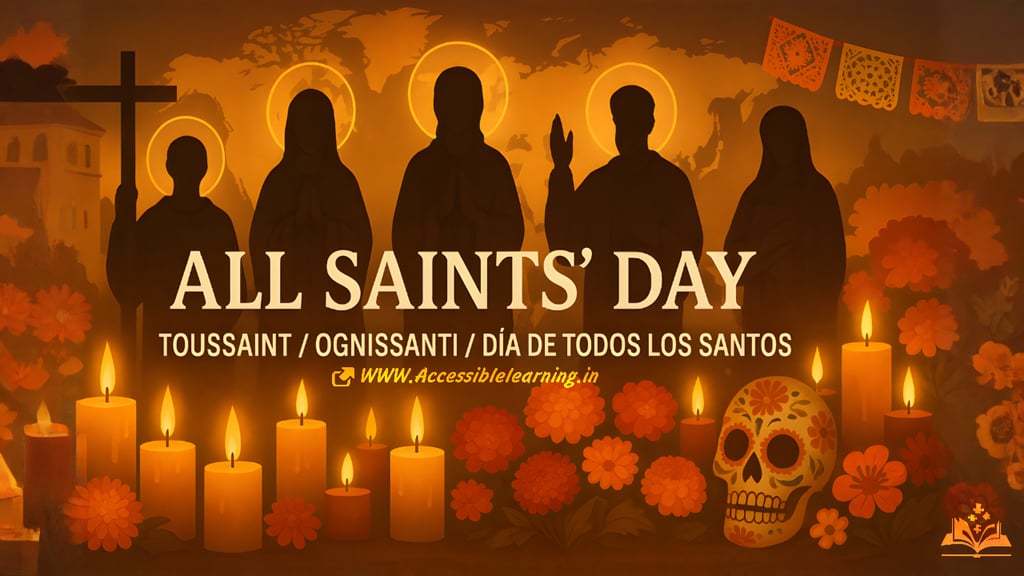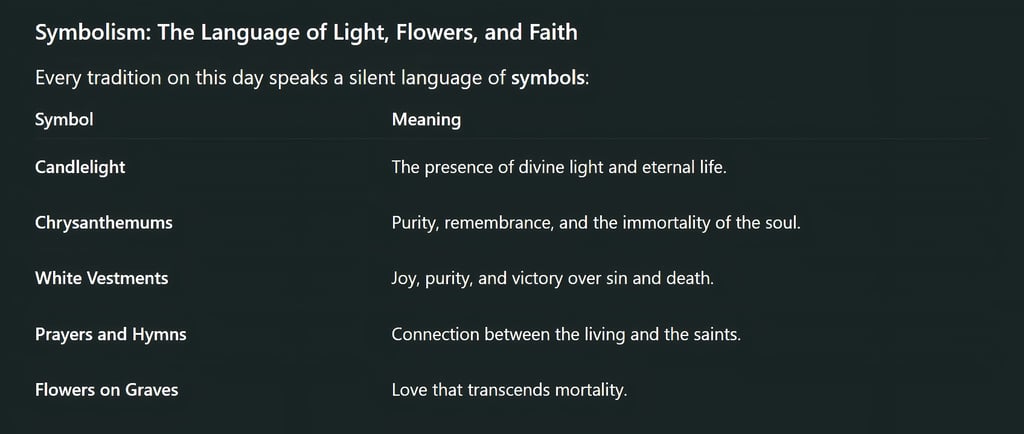
Toussaint / Ognissanti / Día de Todos los Santos: How the World Honors the Saints
All Saints’ Day (Toussaint / Ognissanti / Día de Todos los Santos) is a sacred Christian feast observed on November 1, honoring all saints—known and unknown—who have lived holy and virtuous lives. From France’s flower-filled cemeteries to Mexico’s vibrant altars and the Philippines’ family gatherings, the day unites cultures through remembrance, faith, and gratitude. This in-depth article explores the history, spiritual meaning, global traditions, and modern reflections of All Saints’ Day, revealing how it continues to inspire humanity with hope and light.
EVENT/SPECIALSTORY/ENTERTAINMENTCELEBRATION/FESTIVALSUSA
Kim Shin
10/25/20255 min read


A Day When Heaven Touches Earth
Every year on November 1, the Christian world pauses to celebrate All Saints’ Day—a sacred observance honoring all saints, both those officially canonized and those whose holiness is known only to God.
Whether it’s called Toussaint in France, Ognissanti in Italy, or Día de Todos los Santos in Spain and Latin America, this day stands as a universal reminder of human virtue, eternal hope, and the invisible connection between the living and the divine.
It is not merely a feast for saints—it’s a reflection on what it means to live a life of meaning, sacrifice, and grace.
The Deep Roots: From Martyrs to All Saints
The earliest Christian communities began commemorating martyrs who died defending their faith. By the 4th century, these local observances merged into broader regional feasts.
The turning point came when Pope Boniface IV, in 609 AD, converted the Roman Pantheon into a church dedicated to St. Mary and All Martyrs. This marked one of the earliest forms of what later evolved into All Saints’ Day.
By the 8th century, Pope Gregory III designated November 1 as the official date, followed by Pope Gregory IV, who extended it to the entire Western Church. This alignment possibly coincided with ancient Celtic harvest festivals, merging spiritual remembrance with seasonal transition—from autumn to winter, light to shadow, and life to eternity.
The Spiritual Meaning: A Celebration of Holiness and Hope
All Saints’ Day is more than a remembrance of holy figures; it’s a universal call to sanctity. The Christian belief holds that every person, through faith and good works, is called to become a “saint”—someone who lives in alignment with divine love.
The celebration acknowledges:
The Triumph of Faith: It honors those who lived with courage and conviction.
Communion of Saints: The unity between those in Heaven, those on Earth, and souls in Purgatory.
Eternal Life: A reminder that physical death is not the end but a transformation into spiritual eternity.
For Catholics, this day is a Holy Day of Obligation, requiring participation in Mass and prayer. For others, it serves as a moment to meditate on morality, gratitude, and spiritual connection.
Traditions Across the World
France – La Toussaint
In France, La Toussaint transforms cities and villages into landscapes of remembrance. Families visit cemeteries, placing chrysanthemums and candles on graves. The flowers, bright and enduring, symbolize immortality and love beyond death. Schools close, shops quiet down, and people gather to honor their ancestors—creating an atmosphere of both peace and reflection.
Italy – Ognissanti
Italians celebrate Ognissanti with Mass, processions, and offerings. On November 2, Il Giorno dei Morti (All Souls’ Day) follows immediately. Families prepare special foods like “Fave dei Morti” (Beans of the Dead) — small almond biscuits symbolizing resurrection. Churches echo with prayers, and cemeteries glow at dusk with flickering candles.
Spain and Latin America – Día de Todos los Santos
In Spain, All Saints’ Day is deeply tied to cultural expression. The famous play Don Juan Tenorio is traditionally performed, blending faith with art. In Latin America, particularly in Mexico, the day flows into Día de los Muertos (Day of the Dead)—a vibrant fusion of indigenous beliefs and Catholic tradition.
Families build altars (ofrendas) decorated with flowers, food, photos, and candles to welcome the spirits of the departed. It’s a celebration of memory, love, and the eternal presence of family.
Philippines – Undás
In the Philippines, All Saints’ Day is known as Undás or Araw ng mga Patay. It’s one of the most important national observances. Entire families travel to hometowns, clean tombs, offer prayers, light candles, and share food. Cemeteries become living spaces—filled with laughter, storytelling, and devotion—a heartfelt blend of the sacred and familial.
Poland and Central Europe
In Poland, the night of All Saints’ Day is breathtaking. Millions of candles illuminate cemeteries, creating a sea of light symbolizing eternal life. Similar traditions can be seen in Hungary, Lithuania, and Slovakia, where families gather to pray and decorate graves with flowers and lanterns.
Mexico and Latin America
Although often associated with Día de los Muertos, November 1 is specifically dedicated to children, called Día de los Angelitos (“Day of the Little Angels”). The following day honors adults. These observances embody joy, memory, and the coexistence of life and death in cultural harmony.
United States and the UK
While not as widely celebrated, some Christian communities attend special church services on All Saints’ Day. In Anglican and Lutheran traditions, the focus is on gratitude for faithful predecessors and the inspiration they provide for living believers.



The Connection Between All Saints’ Day and All Souls’ Day
All Saints’ Day (Nov 1) and All Souls’ Day (Nov 2) form a sacred duo of remembrance:
All Saints’ Day honors those in Heaven—a joyful celebration of victory and holiness.
All Souls’ Day prays for those still in purification, awaiting the fullness of divine presence.
Together, they complete the Christian vision of eternity—acknowledging every phase of the soul’s journey beyond death.
Modern Reflections: Why All Saints’ Day Still Matters
In a fast-paced, digital world, All Saints’ Day invites a pause for perspective.
It’s a call to:
Reflect on personal values and moral strength.
Remember those who inspired us through faith, kindness, or sacrifice.
Celebrate the invisible bonds of family, tradition, and humanity.
For the spiritual and non-religious alike, the day holds universal meaning: to honor goodness in all its forms—the saints, the ancestors, and the unsung heroes of everyday life.
Art, Music, and Cultural Influence
All Saints’ Day has inspired countless works of art, music, and literature throughout history.
Mozart’s “Requiem” and Berlioz’s “Grande Messe des Morts” often accompany church ceremonies.
Artists like Giotto and Fra Angelico depicted saints in radiant frescoes symbolizing divine unity.
In poetry, writers like John Donne and Gerard Manley Hopkins explored the mystery of holiness and the human spirit’s longing for transcendence.
These works remind us that faith and creativity often share the same source—the desire to connect with something eternal.
Interesting Facts about All Saints’ Day
The Eastern Orthodox Church observes All Saints’ Day on the first Sunday after Pentecost, emphasizing the universal call to holiness.
In Austria and Germany, people bake Allerheiligenstriezel—a sweet braided bread shared among families.
The celebration’s timing (right after Halloween) connects ancient spiritual themes of death, harvest, and rebirth.
Some African Christian communities blend All Saints’ Day with local ancestral traditions, honoring both saints and forebears.
The custom of visiting cemeteries has led to record attendance levels in many countries, even among younger generations seeking reconnection with their roots.
Frequently Asked Questions
Q. What is the main purpose of All Saints’ Day?
To honor all saints, both known and unknown, and to remind the faithful of their own call to holiness.
Q. Is it related to Halloween?
Yes, indirectly. Halloween (All Hallows’ Eve) occurs the night before, originally marking the vigil of All Saints’ Day.
Q. How is it different from All Souls’ Day?
All Saints’ Day celebrates the saints in Heaven; All Souls’ Day prays for the departed souls still on their journey to eternal rest.
Q. What are common customs?
Attending church, lighting candles, decorating graves, and sharing family meals or prayers.
Q. Can non-Christians observe All Saints’ Day?
Yes. Many people view it as a universal time for reflection, remembrance, and gratitude for those who shaped their lives.
All Saints’ Day stands as a powerful reminder that goodness never dies.
Across languages and cultures—whether called Toussaint, Ognissanti, or Día de Todos los Santos—it unites people through shared remembrance, spiritual connection, and the eternal light of hope.
It is not only a day for saints in heaven but for every soul striving toward goodness on earth. In remembering them, we remember what it means to be truly human — kind, faithful, and luminous in spirit.
Subscribe to our newsletter
All © Copyright reserved by Accessible-Learning
| Terms & Conditions
Knowledge is power. Learn with Us. 📚


